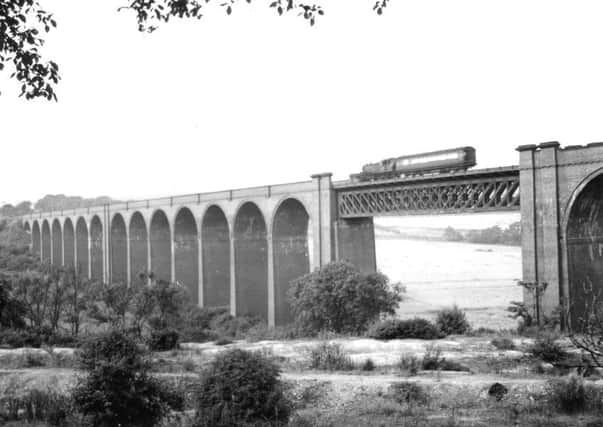Nostalgia on Tuesday: Golden age of rail


In Yorkshire during this period a number of lines were constructed by railway companies who regarded the internal combustion engine as a joke. That smile would soon disappear as motorised vehicles took over.
An ambitious undertaking for commerce and passengers was the Dearne Valley Railway stretching from Shafton junction in the north to Black Carr junction in the south. Along the way links were made to a number of colliery areas including t Grimethorpe, Hickleton, Goldthorpe, Barnburgh, Denaby and Yorkshire Main at Edlington. From Shafton junction the railway linked, via a Lancashire & Yorkshire section, with Wakefield (Kirkgate) and, in the south, from Black Carr, to Doncaster via the Great Northern.
Advertisement
Hide AdAdvertisement
Hide AdThe Dearne Valley Railway Act was incorporated in 1897 and the completed in 1909. The largest shareholders became the Lancashire & Yorkshire Railway.
Building the railway was not without incident. On March 14, 1906 three men were killed and five others slightly injured. In a Home Office report, Captain JH Thompson, HM chief inspector of explosives, said the accident occurred ‘due to the striking of unexploded gelignite by one of the men with his pick’.
Arguably the most spectacular aspect of the route was the viaduct at Conisbrough. The centre is 115ft above the River Don. It consists of 21 arches, 14 on the western or Cadeby bank of the river, and seven on the eastern or Conisbrough bank, connected by an iron girder bridge. The contractors were Messrs Henry Lovat Ltd of London and Manchester and the work was carried out under the supervision of RH Clayton of Doncaster. A Mr Kaye of Leeds was the designer of the viaduct, and John Steel was the clerk of works in charge, on behalf of Messrs Lovat.
John Steel was widely experienced in large engineering contracts but regarded Conisbrough viaduct as the largest thing he had seen in the way of railway bridge building. Each one of the arches within the Conisbrough viaduct has a span of 55ft, varying in height from 40ft at the eastern and western extremities, to 115ft in the centre. In total about 15 million bricks were used and a quantity of these were supplied by local brick firms at Barnsley, Mexborough and Rotherham. The bricks were held together by three thousand tons of cement. Up to 250 men were employed in its construction and it took about three years to complete. One man was killed in the viaduct’s construction.
Advertisement
Hide AdAdvertisement
Hide AdA feature of the work on the Conisbrough viaduct was the overhead travelling cradle, which was used for carrying men and materials to-and-fro across the river. It was technically called a ‘Blondin’ and was an American invention. The cable on which the Blondin operated was 1,875ft in length and was fastened to two 80ft high steel masts, positioned beyond the ends of the viaduct. The cable, with a diameter of 1¾ inches and an ability to lift three tons, was 150ft above the ground at its lowest point.
It was erected by Henderson & Co. of Aberdeen, and on the completion of the viaduct it was sold to aid the construction of the Leeds Corporation reservoir at Masham.
The first Dearne Valley Railway passenger train, which left Wakefield Kirkgate at 8.15am, travelled along the line on Monday June 3rd, 1912. The journey to Edlington (for Balby) took 55 minutes. The 20 or so passengers included a clergyman, ladies and two policemen with four handcuffed prisoners.
Passengers boarded trains at sparse, rail-level halts which included a lamp, name board, and a dilapidated, wheelless railway carriage for shelter.
Advertisement
Hide AdAdvertisement
Hide AdHalts were located at Belle Vue engine shed, Ryhill, Grimethorpe, Great Houghton, Goldthorpe & Thurnscoe, Harlington, Denaby and Edlington. These unstaffed halts were not provided with footbridges as each platform had a separate entry.
For the most part, all of the halts were situated next to the areas they served; the exception being Denaby. Trains terminated at Edlington halt whilst goods trains travelled on to Black Carr and beyond.
To work the services the L&Y brought into use a number of George Hughes-designed steam rail motors which were essentially engine-cum-coach affairs.
The ‘push and pull’ railmotor comprised an 0-4-0T locomotive unit and a carriage articulated to it. Nicknamed Titanics, the L&Y introduced 18 of these railmotors into service between 1906-1911.
Advertisement
Hide AdAdvertisement
Hide AdThe first trailer coaches were 47ft long, seated 56 passengers and had a driving compartment at the opposite end to the engine.
The Press predicted the Dearne Valley passenger service would be “of the greatest value to colliery workers as it runs through the heart of a coalpit district”.
The L&Y was absorbed by the L&NWR in 1922, a year before the Grouping of railways and eventually became part of the London Midland and Scottish Railway.
All the rail motors were scrapped by 1948 and eventually replaced by ex L&Y Aspinall-designed 1008 Class 2-4-2 tanks fitted with push-pull equipment, and finally Ivatt Class 2MT 2-6-2 tank engines which were allocated to Wakefield shed.
Advertisement
Hide AdAdvertisement
Hide AdThe Dearne Valley route for passengers closed on September 9, 1951 as a result of strong competition from bus companies and the growing use of the motor car.
Goods traffic continued for a number of years leaving the Consibrough viaduct as a lasting and perhaps fitting memorial to the Dearne Valley Railway.